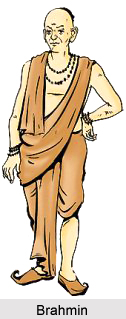 Concept of Brahmin in Brahmanas is such that the Brahmins were raised to an almost God like status. According to the Brahmanas, there are two kinds of Gods, namely the divine Gods and the learned ones on earth, the Brahmins. The Brahmins are said to be the human gods. The sacrifice is divided between these two gods. The sacrificial gifts are for the gods, the presents (Dakshinas) for the human gods, the learned and studying Brahmins. By means of sacrificial gifts man pleases the gods, by presents he pleases the human gods, the learned studying Brahmins: these two kinds of gods transfer him, when they are satisfied, into the blessedness of heaven.
Concept of Brahmin in Brahmanas is such that the Brahmins were raised to an almost God like status. According to the Brahmanas, there are two kinds of Gods, namely the divine Gods and the learned ones on earth, the Brahmins. The Brahmins are said to be the human gods. The sacrifice is divided between these two gods. The sacrificial gifts are for the gods, the presents (Dakshinas) for the human gods, the learned and studying Brahmins. By means of sacrificial gifts man pleases the gods, by presents he pleases the human gods, the learned studying Brahmins: these two kinds of gods transfer him, when they are satisfied, into the blessedness of heaven.
Brahmin has four duties. These include Brahmanic descent, corresponding conduct, fame (gained through erudition) and "ripening of the people"(i.e. offering of sacrifices, by means of which people are made ripe for the Beyond). These ripened people also have four duties towards the Brahmins. They must show them honour, give them presents, may not oppress and not kill them. The property of a Brahmin may under no circumstances be touched by the king; and if a king gives his whole country with all that is in it, to the priests as a sacrificial fee (Dakshina), then it is always understood that the property of Brahmins is accepted. A king can certainly oppress a Brahmin, hut if he does so, evil will befall him. At the consecration of a king the priest says "this man, ye people, is your king; Soma is the king of us Brahmins," to which the Satapatha Brahmana observes:" By this formula he makes the whole nation as food for the king; the Brahman alone he excepts; therefore the Brahmin must not be utilised as food; for he has Soma as his king." Only the murder of a Brahmin is real murder. In a quarrel between a Brahmin and a non-Brahmin the judge must always decide in favour of the Brahmin, for the Brahmin may not be contradicted.
Everything which for some reason or another is taboo, which one may not touch, and cannot use otherwise, as, for example, the stone and earthenware vessels of a deceased person or a cow (intended for the Agnihotra milk) which becomes stubborn or ill, must be given to the Brahmin, especially the remains of sacrifices and food which are taboo for others, for "nothing injures the stomach of a Brahmin." Thus, at last, the conclusion is arrived at, that the Brahman is no longer a "human god" by the side of the heavenly gods, but that he raises himself above the gods. Already in the Satapatha Brahmana it is said that in Him all deities are incorporated. This presumption on the part of the priests, the beginnings of which is seen in the Brahmanas, is not only of the greatest interest for the history of culture as an example of priestly arrogance, but it is also the precursor of a phenomenon which can be traced through the whole of Indian antiquity.
Thus, already in the Brahmanas, the priest exalts himself over the gods through the sacrifice. In the epics one reads of countless stories of ascetics who, through asceticism attain to such ascendancy that the gods tremble upon their thrones. Thus the according to the Brahmanas, the Brahmins occupy a very important position, almost god-like.



















